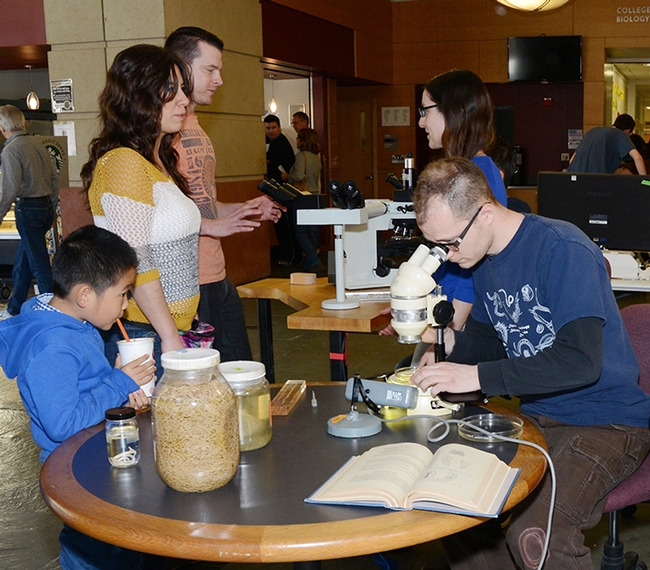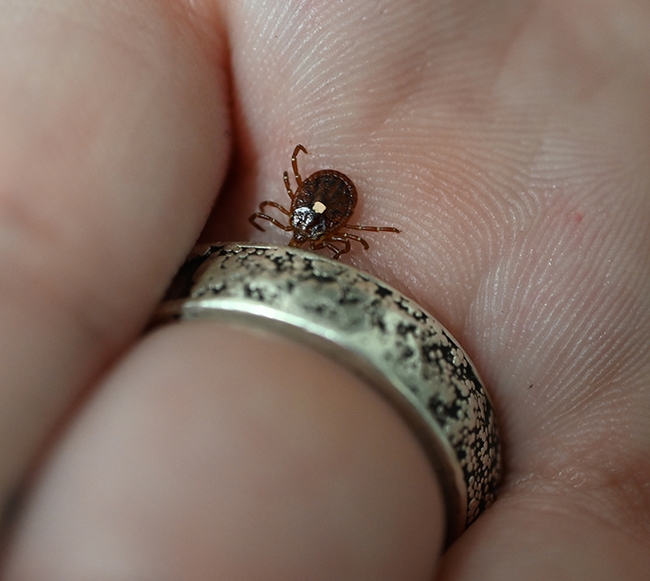- Author: Kathy Keatley Garvey
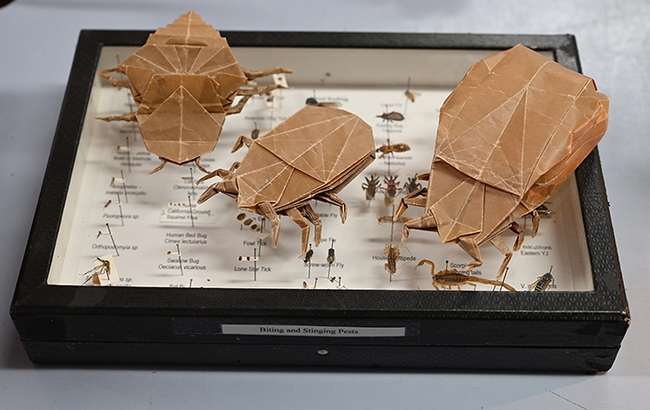
They learned that "medical entomologist is the study of arthropods (such as insects and ticks) that spread pathogens that cause human disease. It is also important to study insects and arthropods that spread diseases to other animals! This field o study is called veterinary entomology. Some diseases affect both humans and animals. This is called a zoonotic disease." (from Bohart Museum poster)
They asked questions. They observed "the vampires" through microscopes. And they left with first-hand information.
The presenters included:
-
Robert "Bob" Kimsey, forensic entomologist, Department of Entomology and Nematology, who answered questions about medical entomology.
-
Luz Maria Robles, public information officer, Sacramento-Yolo Mosquito and Vector Control District, who discussed and displayed mosquitoes and how to keep yourself safe. See https://www.fightthebite.net/
- Carla-Cristina "CC" Melo Edwards, doctoral student and mosquito researcher in the laboratory of medical entomologist-geneticist Geoffrey Attardo, associate professor of entomology, UC Davis Department of Entomology and Nematology, who fielded questions about mosquitoes. Attardo displayed enlarged images of mosquitoes, including a blood-fed Aedes aegypti, and a female and male Culex tarsalis.
- Moriah Garrison, senior entomologist and research coordinator with Carroll-Loye Biological Research (CLBR), (owned by doctoral scientists Scott Carroll and Jenella Loye, affiliated with the Department of Entomology and Nematology), displayed live ticks and mosquitoes.
- Nazzy Pakpour, UC Davis alumna, Novozymes scientist and author, displayed her newly published children's book, Please Don't Bite Me
For the occasion, UC Davis alumnus Kevin Murakoshi, gifted the Bohart Museum a trio of origami sculptures: a tick, an engorged tick and a bedbug. At an earlier open house, he presented the museum with origami sculptures of praying mantises. "They're beautiful," said UC Davis distinguished professor Lynn Kimsey, director of the Bohart Museum. "We're going to display them in our hallway."
The museum houses a global collection of eight million insect specimens, plus a live insect petting zoo (including Madasgascar hissing cockroaches and walking sticks), and a gift shop. It is located in Room 1124 of the Academic Surge Building, 455 Crocker Lane. UC Davis.
The next open house, themed "Monarchs," is set for Saturday, Nov. 4 from 1 to 4 p.m. All open houses are free and family friendly and include a family arts-and-crafts activity. For more information, contact the Bohart Museum at bmuseum@ucdavis.edu or telephone (530-752-0493.
(Part 2 of the open house will be published Friday, Sept. 29)
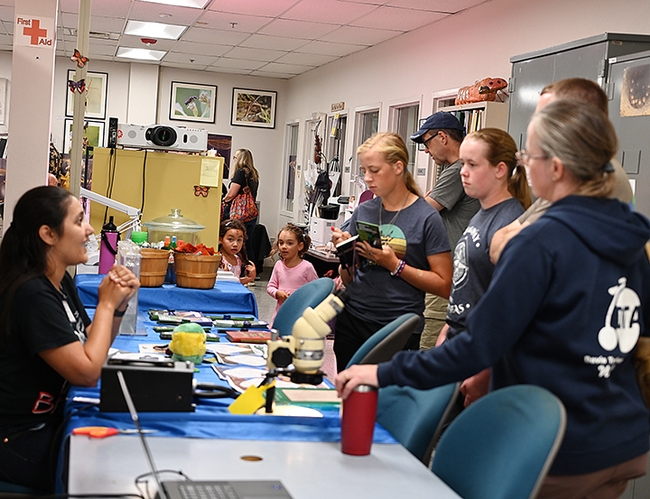
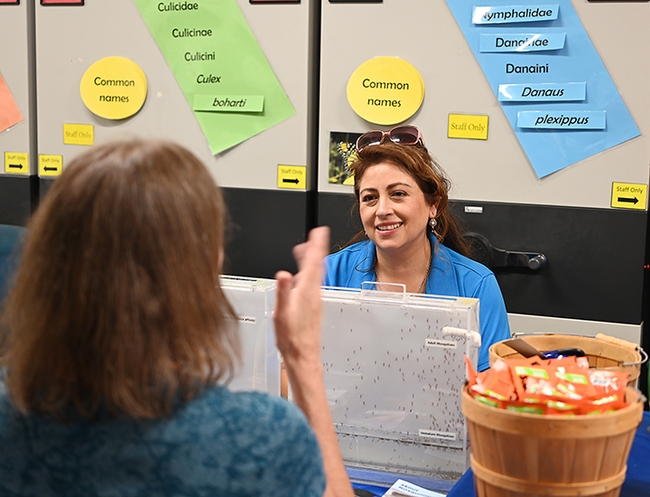
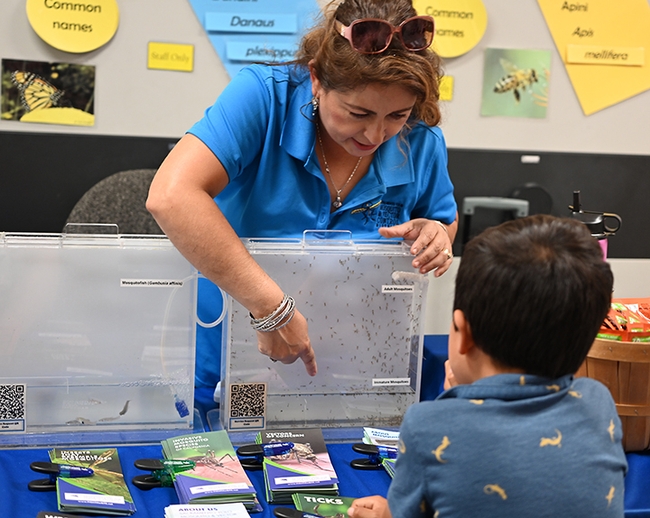
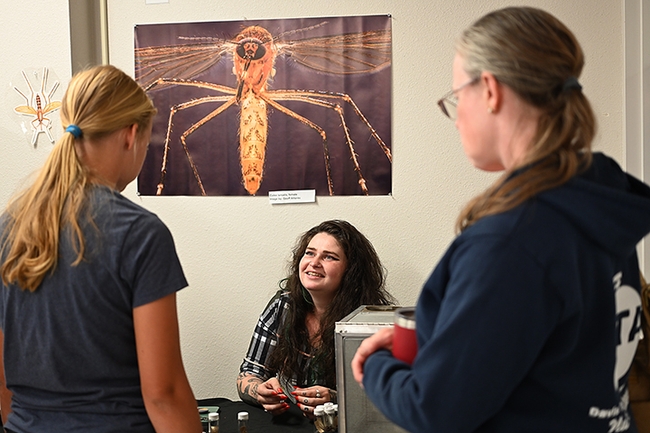
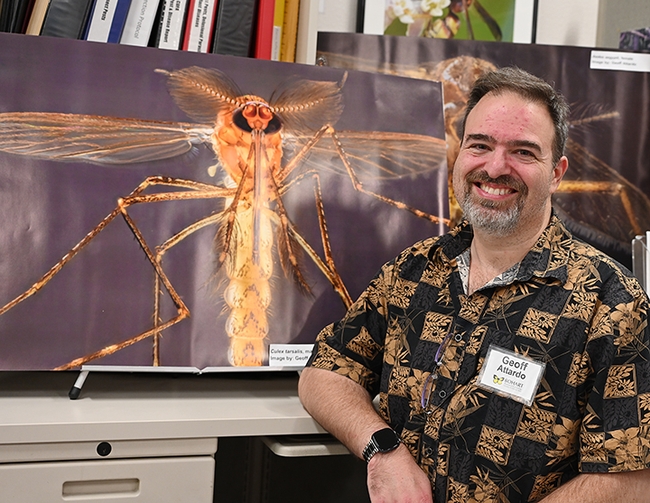
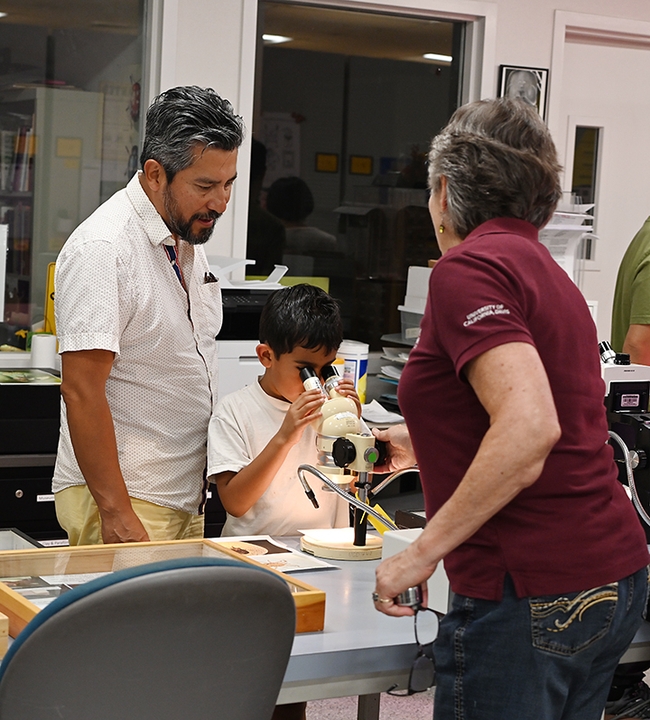
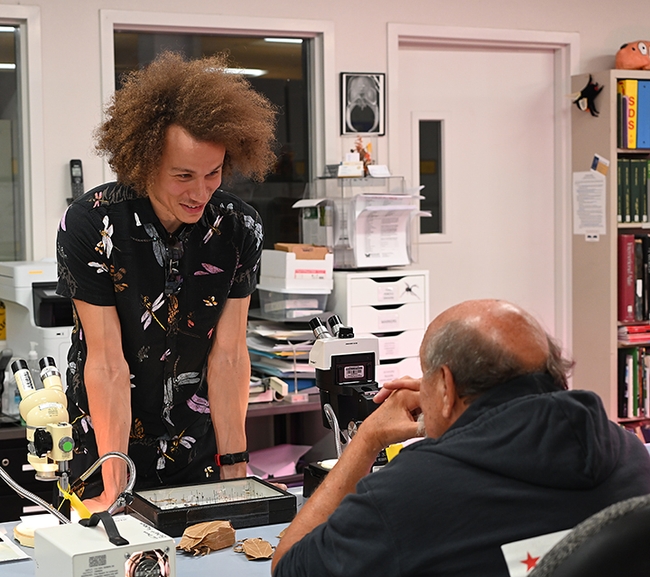
- Author: Kathy Keatley Garvey
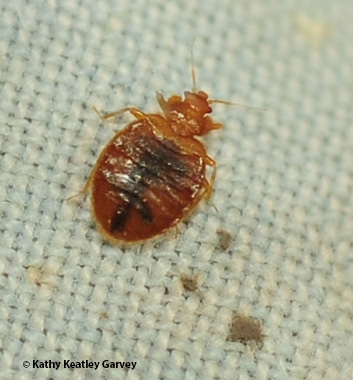
The open house set from 1 to 4 p.m., Saturday, Sept. 23 in Room 1124 of the Academic Surge Building, 455 Crocker Lane, UC Davis. It's free and family friendly and parking is also free. It's an opportunity for attendees to learn more about the "nuisance insects," and ask questions.
The line-up, as of today:
- Lynn and Bob Kimsey of the UC Davis Department of Entomology and Nematology faculty. Lynn, a hymenopterist, is a UC Davis distinguished professor who teaches general entomology and the biodiversity of California insects and serves as the director of the Bohart Museum, and Bob is a forensic entomologist, specializing in public health entomology; arthropods of medical importance; zoonotic disease; biology and ecology of tick-borne pathogens; tick feeding behavior and biochemistry.
- Carla-Cristina "CC" Melo Edwards, a first-year doctoral student in the laboratory of medical entomologist-geneticist Geoffrey Attardo, associate professor of entomology, UC Davis Department of Entomology and Nematology. She will share her expertise on mosquitoes and show specimens.
- Moriah Garrison, senior entomologist and research coordinator with Carroll-Loye Biological Research (CLBR). She is scheduled to show live ticks and mosquitoes and field questions.
- Educators from the Sacramento-Yolo Mosquito and Vector Control District. They will discuss mosquitoes and their program
- Nazzy Pakpour, UC Davis alumna, Novozymes scientist and author of Please Don't Bite Me
- Jeff Smith, curator of the Bohart Museum's ;Lepidoptera (butterflies and moths) collection. He will display butterfly specimens collected globally. Also on the "Lep crew" are Bohart volunteers Greg Kareofelas and Brittany Kohler.
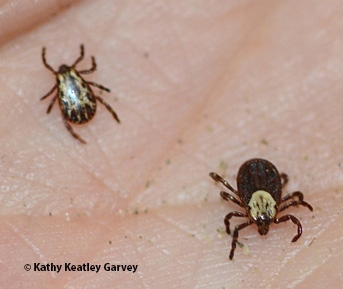
Petting Zoo. A popular attraction is the live petting zoo; visitors are encouraged to hold or get acquainted with live Madagascar hissing cockroaches and stick insects
Family Arts and Crafts Activity. The event will be held outside and will highlight two collecting techniques, said Tabatha Yang, education and outreach coordinator.
- Clear Packing Tape Art. "Clear packing tape is a good way to collect small, hard-to-see insects," Yang said. "Glitter will mimic small insects like fleas or bed bugs. Putting the tape on white paper makes it easy to look at them under a microscope and for this craft it will make a pretty card."
- Making insect collecting or "kill" jars. Participants are asked to bring a recycled jar. "This should be a clean and dried glass jar with a wide, metal top--think jam, pickle, peanut butter jars. Four to 16-ounce jars work well. We will have some on hand as well, but recycling is good! We will fill the bottom with plaster of paris and let it dry and teach people how to use it properly, using something like nail polisher remover containing ethyl acetate as the killing agent. A UC Davis Department of Entomology and Nematology video explains the procedure: https://youtu.be/s8yCzFGzbn8?si=71sNmA5l8NyP1zj0

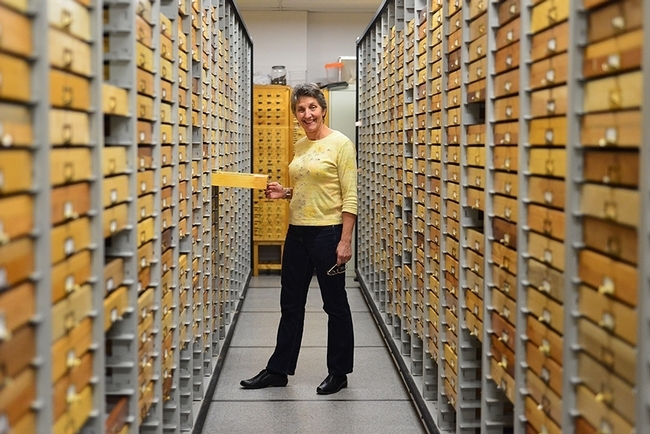
- Author: Kathy Keatley Garvey
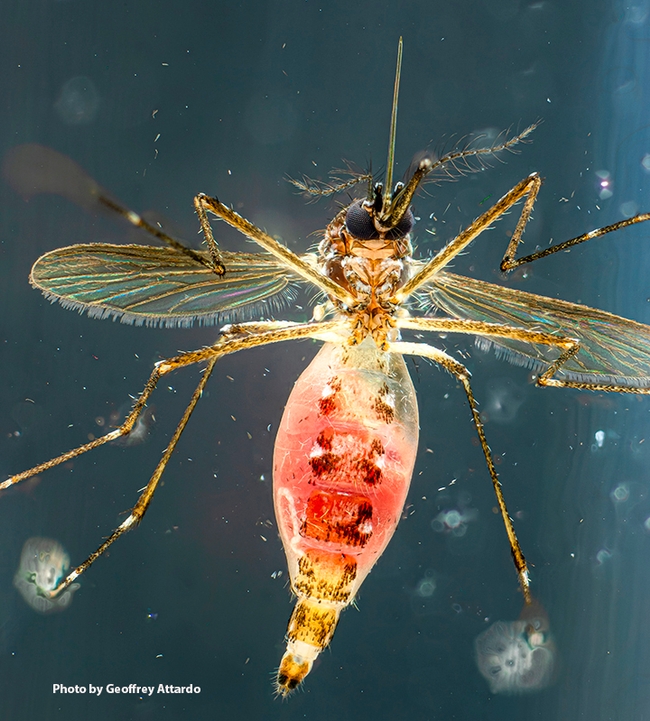
When the Bohart Museum of Entomology hosts an open house on "Household Vampires" from 1 to 4 p.m., Saturday, Sept. 23, activities will take place both inside and outside.
Inside? The presenters will talk about mosquitoes, bed bugs, fleas and ticks in Room 1124 of the Academic Surge Building, 455 Crocker Lane, UC Davis campus. They will show live insects and specimens and field questions.
Outside? The latest news is the family arts and crafts activity.
Tabatha Yang, education and outreach coordinator, announced the the arts and crafts activity "will highlight two collecting techniques."
- Clear Packing Tape Art. "Clear packing tape is a good way to collect small, hard-to-see insects," Yang said. "Glitter will mimic small insects like fleas or bed bugs. Putting the tape on white paper makes it easy to look at them under a microscope and for this craft it will make a pretty card."
- Making insect collecting or "kill" jars. Participants are asked to bring a recycled jar. "This should be a clean and dried glass jar with a wide, metal top--think jam, pickle, peanut butter jars. Four to 16-ounce jars work well. We will have some on hand as well, but recycling is good! We will fill the bottom with plaster of paris and let it dry and teach people how to use it properly, using something like nail polisher remover containing ethyl acetate as the killing agent. A UC Davis Department of Entomology and Nematology video explains the procedure: https://youtu.be/s8yCzFGzbn8?si=71sNmA5l8NyP1zj0
Inside, the presenters will include:
- Lynn and Bob Kimsey of the UC Davis Department of Entomology and Nematology faculty. Lynn, a hymenopterist, is a UC Davis distinguished professor who teaches general entomology and the biodiversity of California insects and serves as the director of the Bohart Museum, and Bob is a forensic entomologist, specializing in public health entomology; arthropods of medical importance; zoonotic disease; biology and ecology of tick-borne pathogens; tick feeding behavior and biochemistry.
- Carla-Cristina "CC" Melo Edwards, a first-year doctoral student in the laboratory of medical entomologist-geneticist Geoffrey Attardo, associate professor of entomology, UC Davis Department of Entomology and Nematology. She will share her expertise on mosquitoes and show specimens.
- Moriah Garrison, senior entomologist and research coordinator with Carroll-Loye Biological Research (CLBR). She is scheduled to show live ticks and mosquitoes and field questions.
- Educators from the Sacramento-Yo;o Mosquito and Vector Control District. They will discuss mosquitoes and their program
- Nazzy Pakpour (Novozymes scientist and author of Please Don't Bite Me)
- Jeff Smith, curator of the Bohart Museum's Lepidoptera (butterflies and moths) collection. He will display butterfly specimens collected globally. Also on the "Lep crew" are Bohart volunteers Greg Kareofelas and Brittany Kohler.
Professor Attardo, who maintains a lab website on Vector Biology and Reproductive Biology at http://attardo-lab.com, and chairs the Designated Emphasis in the Biology of Vector-Borne Diseases, will display some of his mosquito images, including a blood-fed Aedes aegypti, and a female and male Culex tarsalis. Alex Wild, a UC Davis doctoral alumnus and curator of entomology, University of Texas, Austin, will display an image of mosquito larvae that currently hangs in Briggs Hall, home of the UC Davis Department of Entomology and Nematology. Wild's insect images can be viewed on his website, https://www.alexanderwild.com.
The Bohart Museum houses a global collection of eight million insect specimens; a live petting zoo (including Madagascar hissing cockroaches and stick insects); and an insect-themed gift shop stocked with books, posters, T-shirts, hooded sweatshirts and jewelry.
Resource:
Bohart Museum to Spotlight Household Vampires (UC Davis Department of Entomology and Nematology, Sept. 14, 2023)
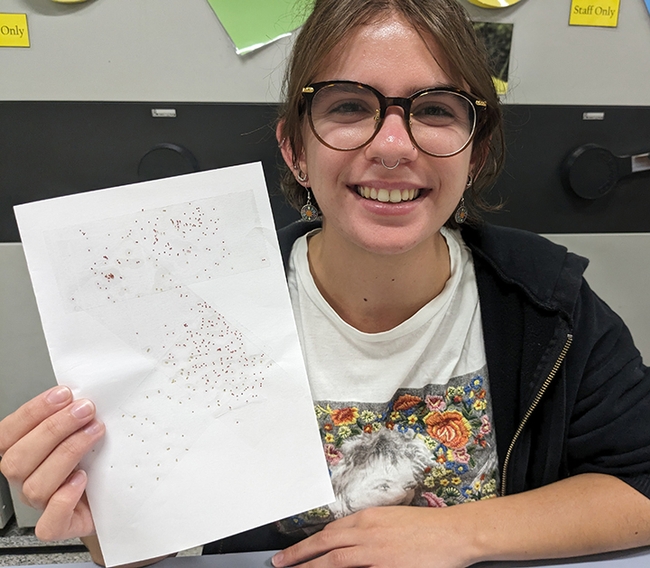
- Author: Kathy Keatley Garvey
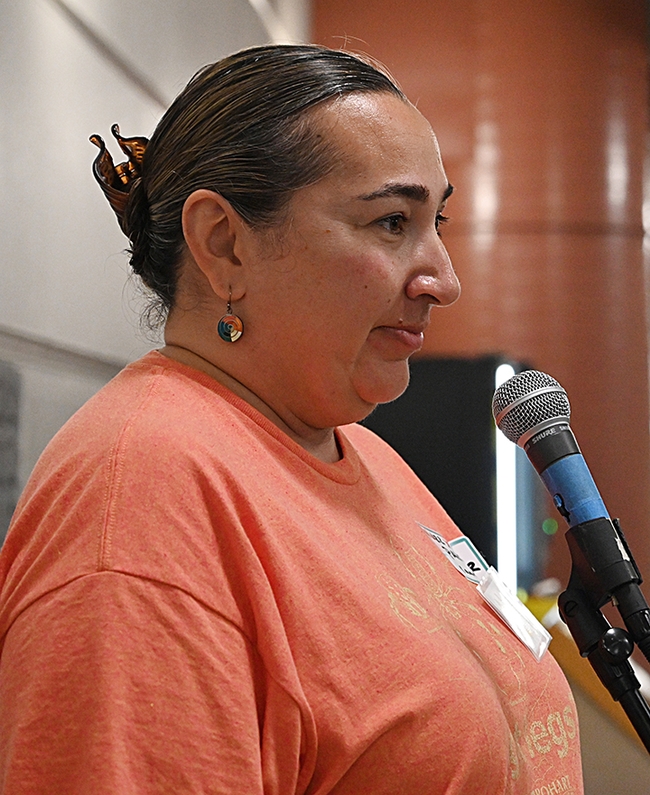
At a recent Bohart Museum of Entomology open house, she read passages from her newly published children's book, Please Don't Bite Me: Insects that Buzz, Bite and Sting, and then encouraged questions.
Each time a youngster raised a hand, she'd say "Yes, my friend!"
She answered each question thoughtfully, expertly, and kindly.
Pakpour, who grew up in the San Francisco Bay Area, is no stranger to UC Davis. She received her bachelor of science degree in entomology from UC Davis in 1999; her doctorate in microbiology, virology and parasitology from the University of Pennsylvania in 2008; and served as a postdoctoral scholar at UC Davis for seven years, leaving campus in August 2015. Her work "focused on determining the effects of ingested human blood factors on the mosquito immune response to malaria."
Passionate about teaching science, Pakpour accepted a faculty position in 2015 at California State University, East Bay, teaching for nearly seven years before moving to the biotech sector. She is a senior scientist at Novozymes, Davis (since January 2022).
A resident of Woodland, Pakpour describes herself as "the mother of two witty and wonderful kids," and as someone who "loves bugs of all varieties, whether they are six-legged or microscopic."
Factoid: She once spent a summer feeding tarantulas at the Smithsonian Natural History Museum.
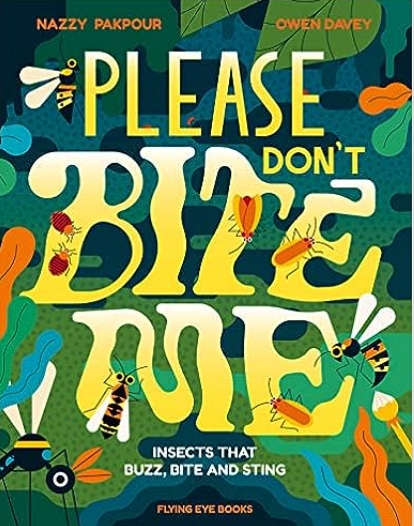
"An insect," Pakpour defines in her book, "is an animal that has six legs, two eyes, two antenna, and three body parts. A special group of scientists called entomologists have been studying insects for hundreds of years an they have learned all kinds of amazing things."
Pakour goes on to say that "our bodies offer a delicious and unique menu of food for a vast variety of insects. These insects drink our blood, live in our homes, and even in our hair! They impact every aspect of our lives, from the clothes we wear, the pets we keep, to the homes we live in, and the way we store our food. Like tiny aliens living among us, each insect has its own unique body, home, and lifestyle."
Some excerpts:
Mosquitoes. "If mosquitoes don't have protein, they can't make eggs, which is why only female mosquitoes feed on blood...Mosquitoes lay their eggs in almost anything that holds water. Once she finds a suitable spot, she will land on the surface and lay around 100 eggs. So they don't sink and drown, the eggs stick together and float like a tiny raft."
Lice. Lice, which are only 0.10 inches long, can move 9 inches in about a minute. "That is about the equivalent of a person who is 5 feet tall moving 450 feet in one minute."
Wasps. Wasps are social insects. "I don't mean social as in they love to throw parties and hang out with their friends. When scientists say an insect is social, it means they live in a group made up of their relatives." She clarifies that only a few specific species are considered pests to humans and "even then it's only when they happen to build their nests near us."
Cockroaches. "Cockroaches give their eggs a little bit of extra protection, wrapping them up like a lovely box of chocolates in a package called an ootheca."
Fleas."Given a choice at the blood buffet, a flea will always choose a cat or a dog over a human."
Bedbugs. "Bedbugs have big appetites and they like to take their time sucking up your blood...The Romans believed eating crushed up bedbugs could cure poisonous snake bites."
Pakpour points out that these insects are annoying but emphasizes that the majority of the 10 quintillion insects in the world "have important and unique roles to play in nature that have nothing to do with humans....Without insects, our entire ecosystem would collapse."
Please Don't Bite Me could easily be called Please Read Me. It's a fascinating book, especially for young entomologists-to-be or children and teens curious about what's living in their world--or what's pestering them. It's an easy read with interesting scientific information spread throughout the book. The illustrations are BBC: big, bold and colorful.
Great book, Nazzy Pakpour!
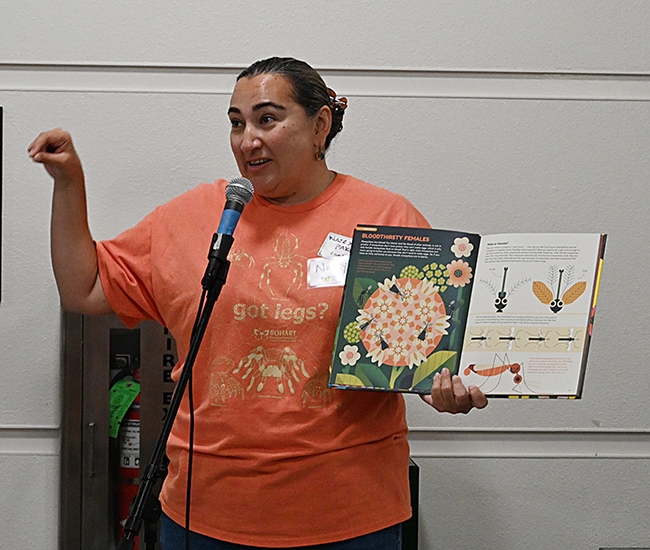
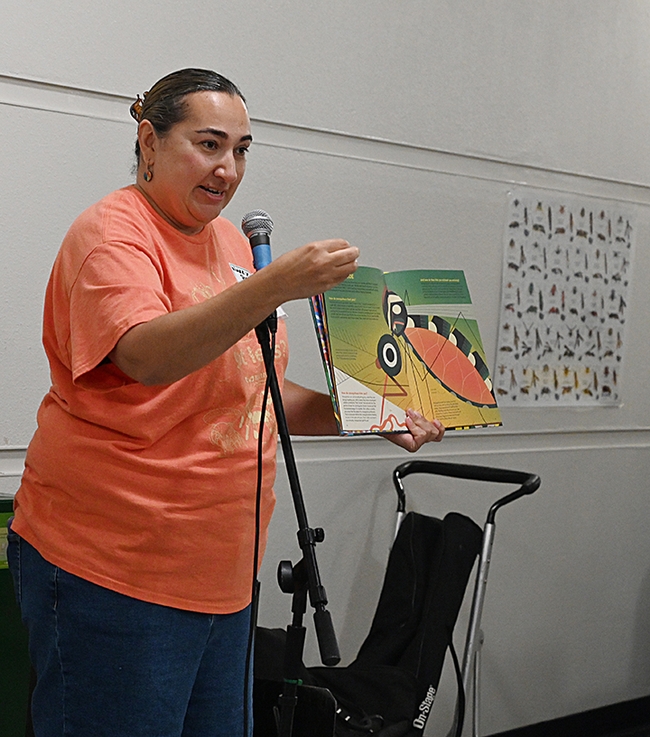
- Author: Kathy Keatley Garvey
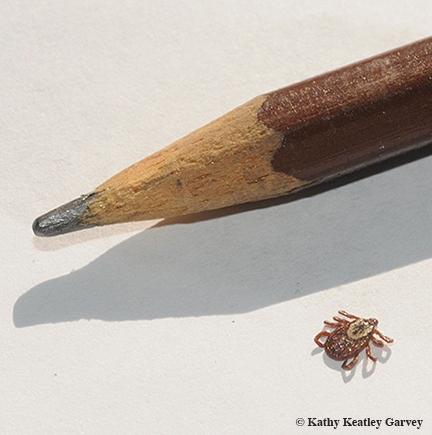
How much do you know about nematodes?
What would you like to know?
You'll be able to learn more about both, plus fleas, mites, lice, bed bugs, botflies and other critters, when the Bohart Museum of Entomology of UC Davis hosts an open house on “Parasite Palooza: Botflies, Fleas and Mites, Oh, My” from 1 to 4 p.m., Sunday, Jan. 22 in Room 1124 of the Academic Surge Building, Crocker Lane.
It's free and open to the public. You can meet scientists one-on-one and ask questions.
Senior public health biologist Mike Niemala of the California Department of Public Health will participate in the three-hour open house, discussing ticks and other health issues, and handing out fliers and brochures. He received his master of science degree from UC Davis.

What are nematodes? That's a question often asked of nematologists.
"Nematodes are a large group (phylum) of roundworms," Camp said. "Most nematodes are not parasites, but people may be familiar with some of the parasitic species. Some well-known nematode parasites of humans are pinworm, Ascaris, hookworm, and guinea worm. Dogs and cats can also become infected with nematodes including heartworm, hookworm, or Toxocara."
Camp, who grew up in rural northern Indiana, received her bachelor's degree in biology in 2005 from the University of Chicago and her master's degree in biology in 2007 from Wake Forest University, Winston-Salem, N.C. As a UC Davis graduate student, she focused on the evolutionary relationships and genetic diversity of Baylisascaris procyonis, a nematode parasite of raccoons. Her career plans? Researcher in infectious diseases or genetics/genomics or a science communicator.
"I first became interested in parasites during my undergrad degree at the University of Chicago," Camp said. "My specific interest in nematode parasites developed when I read some of Dr. Nadler's work on the evolutionary relationships of nematodes for an invertebrate biology class. Nematodes are an amazing phylum of organisms- they exist in almost every known environment on the planet, and different species eat everything from bacteria and fungi to plant and animal tissue. I find parasites particularly fascinating, because they are dependent on another organism (or organisms) for part or all of their life cycle."
The Bohart Museum event is free and open to the public. For the family craft activity, attendees will attach stickers of parasites on origami paper hats.
The Bohart Museum, directed by Lynn Kimsey, UC Davis professor of entomology, is a world-renowned insect museum that houses a global collection of nearly eight million specimens. It also maintains a live “petting zoo,” featuring walking sticks, Madagascar hissing cockroaches and tarantulas. A gift shop, open year around, includes T-shirts, sweatshirts, books, jewelry, posters, insect-collecting equipment and insect-themed candy.
The Bohart Museum's regular hours are from 9 a.m. to noon and 1 to 5 p.m. Mondays through Thursdays. The museum is closed to the public on Fridays, Saturdays and Sundays and on major holidays. Admission is free.
More information on the Bohart Museum is available by contacting (530) 752-0493 or bmuseum@ucdavis.edu.
